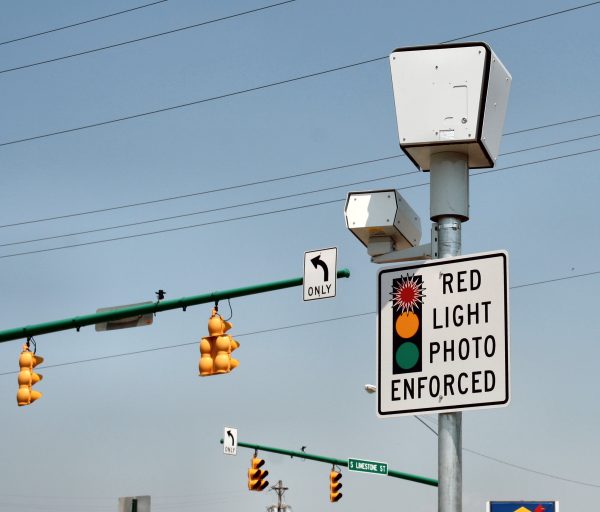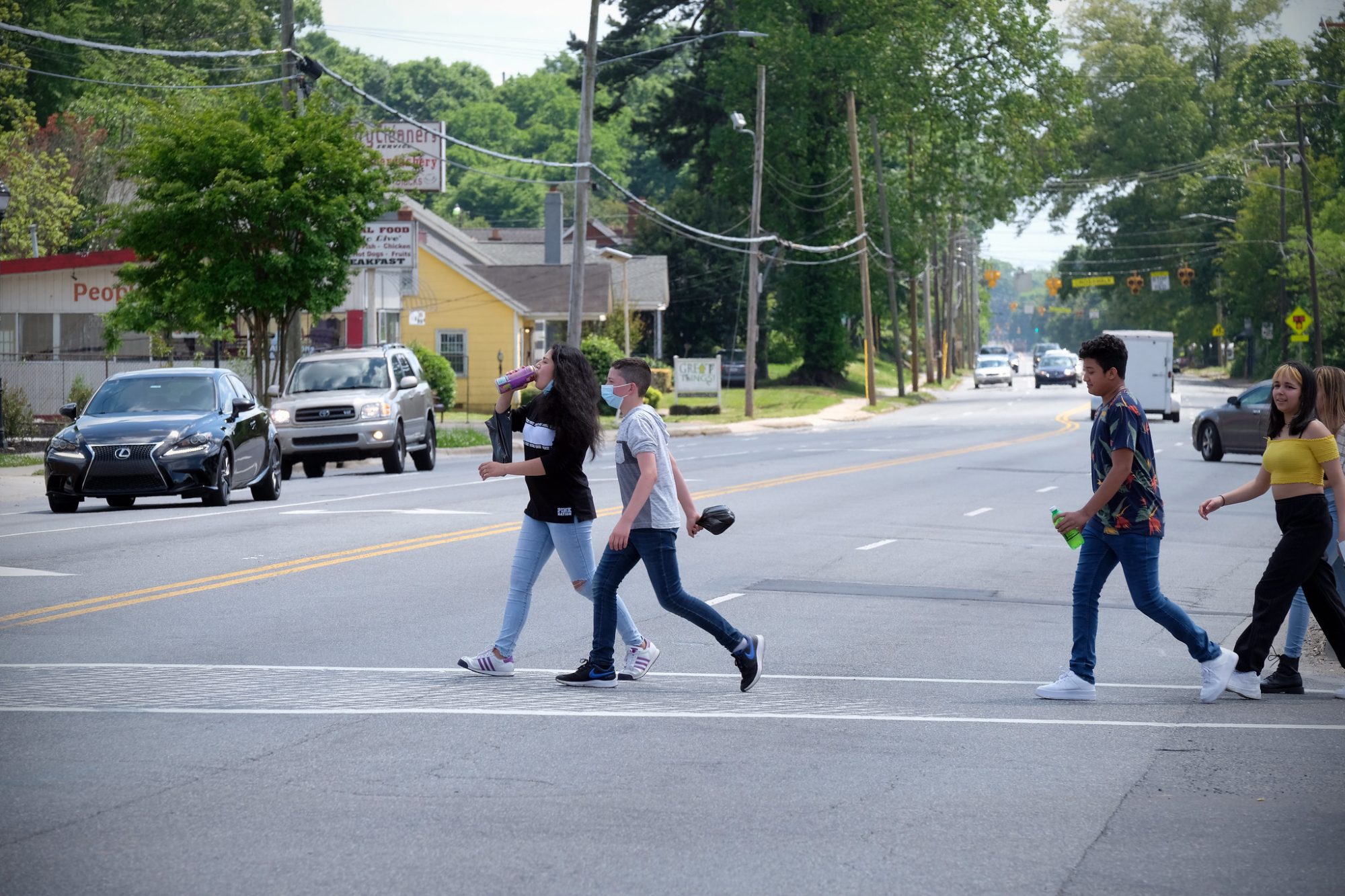Should Charlotte bring back traffic cameras?

The city of Charlotte has a problem: Despite pledging to end traffic deaths by 2030, we’re on pace to see as many or even more people killed on the roads this year than last, and officials say speed is the single biggest contributing factor.
Could automated cameras to catch speeders and nab red light-runners be part of the answer, especially as Charlotte-Mecklenburg Police write drastically fewer citations? A Charlotte City Council committee plans to examine the use of technology to enforce traffic laws, but it’s far from clear that there’s any enthusiasm for bringing back cameras — a program Charlotte ended more than a decade ago.
“I think we absolutely should be pursuing it,” said Mayor Pro Tem Julie Eiselt, in an interview. “I’ve asked council members, and nobody speaks up for it. And if council doesn’t speak up for it, staff’s not going to pursue it…I don’t really understand it.”
If there’s an epidemic of vehicle deaths and speed is the No. 1 contributing factor, then speed cameras might seem like an obvious solution. Indeed, a study by traffic engineers at N.C. State after Charlotte’s mid-2000s dalliance with speed cameras showed they not only lowered accidents during the years they were deployed, but left a carryover effect that lingered for years, reducing accidents even after the cameras were removed.
Plus, speed cameras — and their cousins red-light cameras — could remove some of the selective, possibly biased elements from policing and traffic stops (though obviously where they are installed would be a factor with selective enforcement), by automating the process of enforcement. You’re well over the speed limit, or you run a light, and you get a civil fine, end of story.
To understand why Charlotte doesn’t jump right back in and start installing cameras, you have to rewind and look at a few different factors: The scope of the problem, the kinds of cameras that were allowed in Charlotte, a court ruling that changed the funding equation, and Dillon’s rule.
Rising traffic deaths
As WFAE previously reported, Charlotte averaged 39 traffic fatalities from vehicle crashes and pedestrians being hit between 2008-2012.
That’s more than doubled. Last year, 81 people died in vehicle wrecks. This year, Charlotte is on track to equal or exceed that toll. Just Monday, one person was killed and another badly injured on I-77, the second fatality on that interstate in Charlotte this month. Last week, a CMPD officer was injured when a speeding driver hit a police cruiser at Monroe Road and Village Lake Drive, flipping the police vehicle on its roof.
[Read more: Despite plans to end traffic deaths, Charlotte is headed in the wrong direction]
“We know that speeding leads the way as far as contributing factors to those wrecks,” CMPD Maj. Dave Johnson told City Council earlier this month.
The deaths and injuries on Charlotte’s roads are taking place against a backdrop of fewer citations and traffic stops. As the Charlotte Ledger previously reported, traffic citations from CMPD have been falling for years, plummeting from 58,000 in 2014 to barely 30,000 in 2018, for example. The trend isn’t limited to Charlotte: The Charlotte Observer detailed a rapid drop in traffic enforcement statewide in a major series this summer on egregious speeding and rising traffic fatalities.
Meanwhile, Charlotte embarked on a plan called “Vision Zero” more than two years ago, with the ambitious goal of eliminating traffic deaths and serious injuries within the decade.
Previous camera programs
Charlotte operated red-light cameras from 1998 through 2006, and the city operated a pilot speed camera program from 2004 to 2006. The North Carolina General Assembly passed legislation that specifically allowed the cameras.
But, due to the way the law was written, police officers still had to be present to witness the speeding and issue a citation. So, CMPD rotated officers in vans with automated cameras between 14 designated corridors — mostly near schools — identified as trouble spots.

From 2004-06, Charlotte ran a speed camera program in which officers in “Safe Speed” vans (left) in 14 corridors used cameras (right) to detect speeders and send them tickets in the mail. (Photo from N.C. State study)
The program wasn’t the same as truly automated, autonomous cameras that are permanently installed in one spot. I’m from Montgomery County, Md., where speed cameras are ubiquitous (You can check out the hundreds of cameras, blanketing a county smaller than Mecklenburg, here). Drive past them speeding, and you’re guaranteed to get a citation in the mail a few weeks later.
Still, despite its limitations, Charlotte’s program appeared to work. The percentage of cars exceeding the speed limit by more than 10 mph dropped 55% at targeted locations, one study found (more than 90% of total citations were issued along Independence Boulevard, Tryon Street, South Boulevard, Central Avenue, and Billy Graham Parkway, and enforcement was heavier during the day). A subsequent study concluded total collisions in the target areas dropped 15%-18%, and that the decrease appeared to carry over for at least the two years the authors studied.
The researchers recommended Charlotte continue and expand its automated speed enforcement program.
“The team recommended that the City of Charlotte continue supplementing regular speed enforcement with the automated enforcement program. The team highly recommends enforcing all corridors more equally to get a better overall effect, as well as enforcing equally during nighttime hours so that decreases in nighttime collisions might approach the decreases seen in daytime collisions.”
The programs end
But, that didn’t happen. In 2006, a driver sued High Point over a red light ticket. The courts ruled that, while the automated traffic enforcement was legal, under state law 90% of the proceeds of those cameras had to go to local school systems.
That meant cities that had been paying private contractors via fines to operate red-light cameras — like Charlotte — could no longer do so. It also meant that Charlotte would have to pay Charlotte-Mecklenburg Schools the vast majority of money made from its speed camera operation, instead of using those funds to cover CMPD’s costs.
In 2006, the last full year, Charlotte’s speed and red-light camera programs cost $2.1 million to operate and brought in just under $2.8 million. But with the city turning over 90% of revenues to the schools, that would mean giving CMS more than $2.5 million of that revenue.
Charlotte suspended its camera programs and ended up paying CMS $4.7 million from the program’s total proceeds. Most other cities followed suit, dropping their camera programs once it was clear they wouldn’t be revenue generators.

Young people crossing Beatties Ford Road near West Trade Street. Photo: Nancy Pierce
Now, only four North Carolina municipalities — Fayetteville, Raleigh, Wilmington and Greenville — operate red-light cameras, for a total of more than 50 among them. Each city issues between 2,000 and 3,800 citations a month, on average, doling out $50 fines in the mail.
No municipalities in the state use speed cameras, according to a report from the NC Governor’s Highway Safety Program.
Permission from the state?
Charlotte could decide to bring back speed cameras, despite the cost. After all, the city spends money on plenty of other services that don’t break even or generate revenue.
When the camera programs come up — as they have intermittently over the past few years — staff has consistently pointed at costs as a reason to be wary of bringing speed cameras back.
“It costs a lot, much more than the 10% administration that was allowed under the legislation, to really run this program,” said Charlotte Deputy Transportation Director Debbie Smith, at a City Council meeting earlier this month. Much of the city’s attention now is focused on redesigning dangerous roads to make them less conducive to speeding.
“Enforcement is one way to do this, but it’s kind of like a flash in the pan vs. a continuous improvement,” Charlotte Mayor Vi Lyles said this month on “Charlotte Talks,” comparing design changes to stepped-up enforcement. “We want continuous improvement that modifies behavior.”
Still, redesigning roads for greater safety is expensive, too: The 0.8 miles of protected bike lanes and road diet on Parkwood Avenue that opened this month cost $3.7 million, more than the annual cost of Charlotte’s previous camera enforcement programs.
But there’s one more wrinkle: Even if Charlotte decided the cost is worth it, bringing back speed cameras would require permission from the NC General Assembly (red-light cameras are still enabled under the state’s rules).
North Carolina is what’s known as a Dillon’s Rule state. That means cities like Charlotte don’t have the authority to do a lot without specific enabling legislation (something you’ll often hear City Council lament), whether that’s putting a transit sales tax before voters or implementing automated traffic enforcement cameras. The enabling legislation Charlotte relied on before shutting down its speed camera programs expired more than a decade ago and hasn’t been renewed.
According to the NC Governor’s Highway Safety Program, a bill introduced multiple times in the last few years to enable 20 municipalities to operate automated enforcement programs has died in various committees.
Council member Larken Egleston said in a committee meeting this August that it could be worth asking Raleigh to let Charlotte restart the program.
“This is another one that’s going to require some partnership and some lobbying in Raleigh,” he said. He pointed to the strain of manual traffic law enforcement for a police force that’s already stretched thin. “We have severely overburdened our police officers in taking something off of their plate that could be handled by a technology solution.”
Exploring legislation that would allow automated speed cameras citywide is included as a goal in Charlotte’s Vision Zero plan. But with the city already looking to make big asks in Raleigh over the next year or so — chief among them the multibillion-dollar transit plan requiring a 1-cent sales tax referendum in Mecklenburg — it’s not clear whether there will be appetite for pursuing a bill.
City Council’s Safe Communities committee is expected to report in early December on “technology solutions” that could help Charlotte curb speeding and vehicle wrecks. But as Eiselt put it for speed cameras: “If the state doesn’t allow us to do it, there’s not much we can do.”
This story originally appeared in Transit Time, a newsletter produced by the Charlotte Ledger, WFAE and the UNC Charlotte Urban Institute.